A medical alert system is a great way to give yourself or a loved one the peace of mind that possible help is never more than a button push away. These devices benefit adults who may want to age in place at home, those recovering from surgery, or anyone with chronic health conditions who may want urgent medical attention. (1) Medical alert systems connect to a 24/7 monitoring center, where a trained agent can contact emergency responders, loved ones, or both, depending on the situation.
While today’s best medical alert systems are less bulky and more sleek than devices from the 1970s and 1980s, some people may still hesitate to wear one in and around their homes.
GetSafe’s medical alert devices don’t have to be worn—the base unit and wall buttons work throughout your home via voice activation, push buttons, and pull cords. We like this option for anyone hesitant to wear a traditional medical alert necklace or an older adult who may forget to wear their device.
Our favorite GetSafe medical alert system
We selected GetSafe Standard as the brand’s top package. According to GetSafe, the Standard is designed for two—and three-bedroom homes and is the most popular product. It includes a base unit, two voice-activated wall buttons, one standard wall button, and a wearable help button. Both voice-activated buttons have a two-way speaker, allowing users to communicate with the monitoring center during an emergency.
Our picks for the best GetSafe medical alert systems
Compare GetSafe medical alert systems
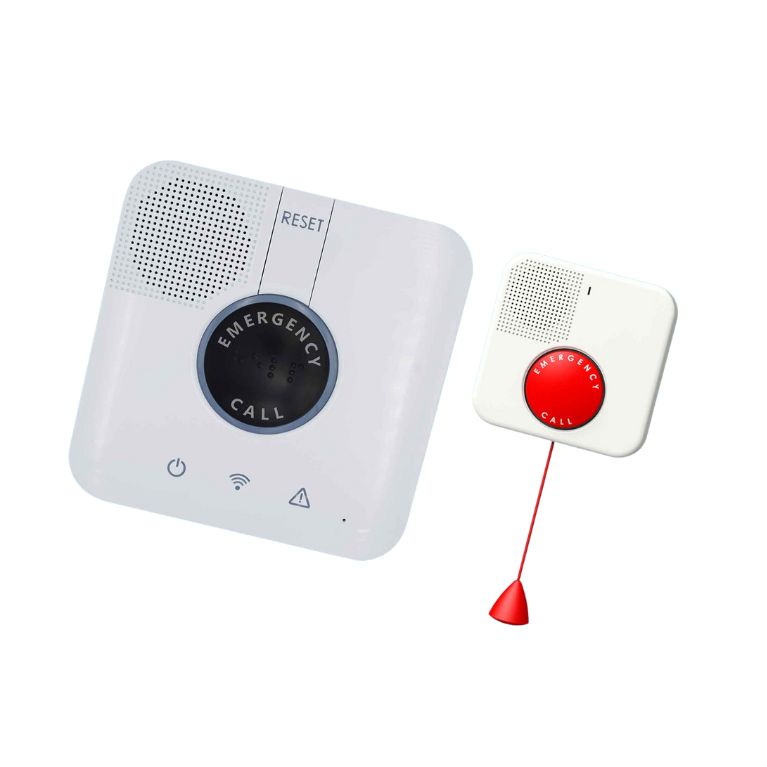
|
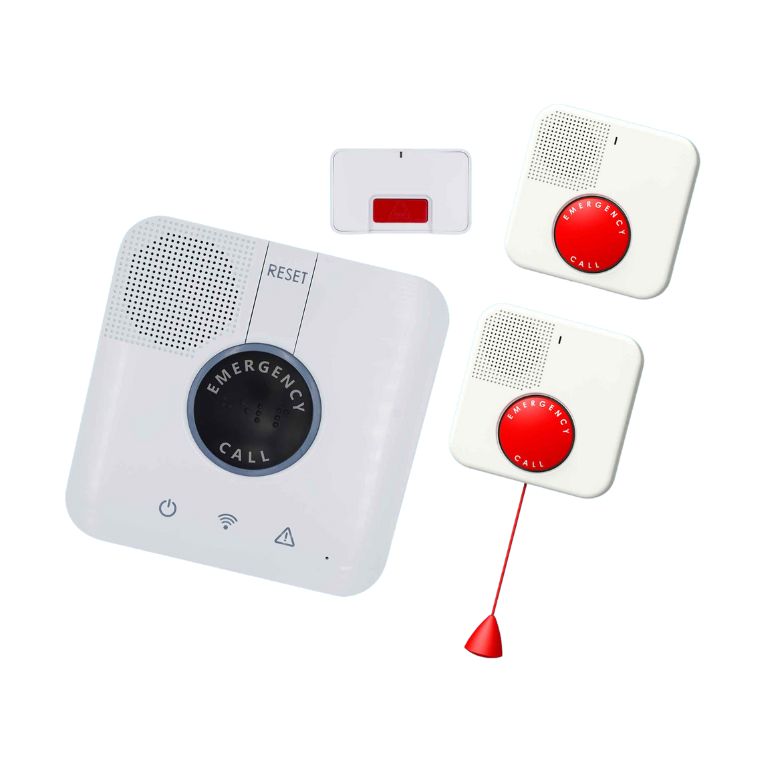
|
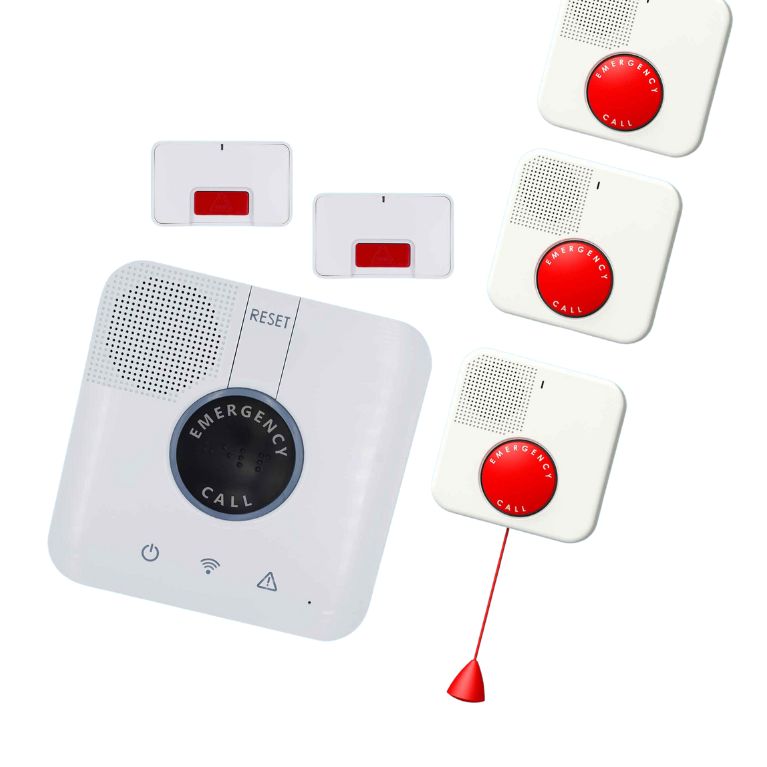
|
|
| GetSafe Standard | GetSafe Starter | GetSafe Select | |
| Rating | |||
| Monthly price | $29.95 | $29.95 | $29.95 |
| Equipment fee | $179 | $79 | $279 |
| Equipment included | Base unit, two two-way voice-activated wall buttons, one standard wall button | Base unit, two-way voice-activated wall button | Base unit, three two-way voice-activated wall buttons, two standard wall buttons |
| Fall detection | Yes, $10/month | Yes, $10/month | Yes, $10/month |
| Battery life | 32 hours (base unit) | 32 hours (base unit) | 32 hours (base unit) |
| In-home range | 800 feet | 800 feet | 800 feet |
GetSafe Standard
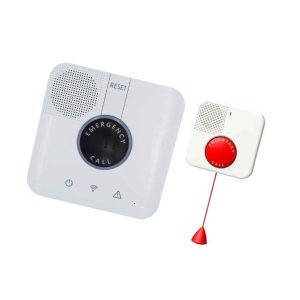

Key product features
What you should know
The GetSafe Standard is designed for two- and three-bedroom homes. It includes a base unit and multiple wall buttons, making it an excellent option for anyone who may not want to wear a traditional medical alert bracelet or for adults who may forget to wear their device.
- GetSafe voice-activation buttons allow you to contact the monitoring center with your voice and speak directly to the agent. Each package includes at least one voice-activated button. We recommend testing this feature before an emergency call.
- While the monthly monitoring fee is a reasonable $29.95, there’s a hefty $179 one-time equipment fee.
- GetSafe Standard is recommended for those living in a two- or three-bedroom house who only need at-home monitoring.
- A standard fall detection necklace is available for $10 per month.
- All wall buttons must be within 800 feet of the base unit to contact the monitoring center.
GetSafe Standard overview
GetSafe medical alert systems stand out compared to other systems we’ve tested because you don’t always have to wear a necklace or bracelet to call the monitoring center. This is likely beneficial if you or a loved one doesn’t like wearing a bulky device or forgets to put it on.
The GetSafe Standard package includes a base unit, two voice-activated wall buttons with a two-way speaker, one standard push button, and a help button that can be worn as a necklace or bracelet. We like that all packages include a wearable help button as a backup option for an added sense of security.
The Standard should fit most two- to three-bedroom homes. The wall and wearable help buttons work within 800 feet of the base unit.
Most medical alert wall buttons only allow users to speak with the agent through the base station. However, GetSafe’s voice-activated buttons have a two-way speaker that connects directly with the monitoring center agent. This is an excellent feature if you or a loved one may have problems with mobility and might have difficulty getting to the base unit in an emergency.
Our testing experience was average. While the device was simple to set up and use, some features, such as voice activation and initial speaker quality, were disappointing to us. We also couldn’t test fall detection since the brand didn’t enable that feature when sending us its product for testing.
Specs
| Monthly cost | $29.95 |
| Trial period | 30 days |
| Fall detection | Yes, $10/month |
| Average response time | 74 seconds |
| Connectivity | Cellular |
| App | Yes |
| Available accessories | Push wall buttons, voice-activated wall buttons, lockbox |
Setting up and testing GetSafe
Our testers liked that the quick start guide explained the meaning of each light and blinking pattern on the base unit, especially since there are quite a few. GetSafe also offers helpful online tutorial videos to guide the installation process.
When setting up the voice-activated wall button with the pull cord, our testers accidentally pressed the emergency button a few times. Fortunately, it’s simple to cancel a call to the monitoring center by pressing the “Reset” button on the base unit within 45 seconds of the call.
We were disappointed that the package’s voice-activation feature didn’t work when we tested the two-way wall buttons. After reciting the prompt phrase “Call 911” twice, the wall button didn’t contact the monitoring center. However, it did contact the monitoring center when we pushed the button or pulled the cord. We encourage you to test the voice activation feature before an actual emergency. If the feature doesn’t work, contact customer support.
During some test calls, our testers couldn’t hear the monitoring agent through the base unit speaker at first. Fortunately, as the conversation continued, testers could hear the agent just fine but noted that adults with hearing loss may have trouble communicating with the agent.
“It seems like when the agent first starts speaking, it’s not easy to decipher,” a product tester said. “But when they respond again, we can understand what they are saying.”
Build callout box: We recommend placing wall buttons in high-risk fall areas like the bathroom, bedroom, or bottom of stairs. (2) Place the wall buttons close to the floor to reach them after a fall.
Fall detection
Fall detection is available for $10 per month. Unfortunately, we couldn’t test the fall detection necklace since the company didn’t enable the feature when it sent us the equipment. We hope to test GetSafe fall detection in the future.
Read our fall detection review to learn about the top devices we’ve tested.
Battery life
The two-way speaker and standard wall button batteries last 1.5 to 5 years, while the help button necklace or bracelet lasts up to five years.
We confirmed with a customer service representative that agents monitor all buttons. An agent will let you know when the battery is low and needs to be replaced. You can replace wall button batteries on your own if you choose, but GetSafe will also send you a new wearable help button if you desire. (3)
Available add-ons
GetSafe offers three packages: Starter, Standard, and Select. You can add the following accessories and features to any package to better meet your needs:
- Fall detection: For $10 a month, you can add a fall detection necklace to any GetSafe package. The necklace works within 800 feet of the base unit.
- Two-way speaker wall buttons: Add up to four wall buttons with two-way speakers to your package. You can call the monitoring center via voice activation or a pull cord ($79 each).
- Standard wall buttons: Add up to four buttons ($35 each). Standard wall buttons have a push button to contact the monitoring center. They don’t have a two-way speaker, voice activation, or pull cord.
- Wearable help button: You can add up to four help button necklaces or bracelets ($25 each).
- Lockbox: A lockbox stores your house keys outside your house in case emergency responders need to enter your home. The monitoring center agent will pass the lockbox code to responders so they can enter your home without damaging your doorway ($30 each).
- Mobile GPS: You can add a mobile medical alert necklace to any package for $30 per month plus a $99 one-time equipment fee. The Mobile GPS works anywhere with cellular service and includes location tracking via the GetSafe app (available for iOS and Android devices). Fall detection is available for an additional $10 per month.
What customers are saying
GetSafe earned an average of 4.6 out of 5 stars from more than 130 Google reviews. Many reviewers praise how easy it is to install and use the medical alert system, while others were pleased with the company’s excellent customer service. Positive reviews also mention the fast response time when calling the monitoring center. –
“This company has provided wonderful service. Everyone is very helpful and nice. I feel so much better about my mom who has many health conditions being alone. She has set off her alarm a couple of times accidentally, and I was immediately notified when they couldn’t reach her. So glad we invested in this service. Gives me peace of mind.”
Patricia Z., Google Review
Most negative reviews mention issues with the device working properly, including multiple false alarms. Other reviewers had trouble canceling their subscriptions and getting a refund.
GetSafe earned 4.4 out of 5 stars from an average of more than 40 customer reviews on Trustpilot. Most reviews are for GetSafe’s home security system, not its medical alert devices. The only review mentioning a GetSafe medical alert system is a negative review of the GPS mobile system. The customer complained it didn’t work properly, and they had issues receiving a refund.
We’ve featured GetSafe medical alert systems in:
Who GetSafe Standard is recommended for:
When shopping for a medical alert system, consider your lifestyle, budget, and needs. We offer the following recommendations when deciding whether GetSafe is right for you or your loved one, but ultimately, you’ll know what’s best for you.
- Those who prefer a non-wearable medical alert device: GetSafe speakers are placed throughout the home so you can contact the monitoring center without wearing a necklace or bracelet. This is a great option for anyone who doesn’t want to wear a medical alert device or may forget to wear it.
- People living in a small apartment or home: The smaller your space, the lower the equipment fee. GetSafe Standard is designed for one- to two-bedroom homes and has a $179 fee, while the Starter package fits studio apartments, condos, or small one-bedroom homes with a $79 equipment fee. The Select package has a $279 equipment fee for four to five bedrooms.
- Those living alone but accompanied by a caregiver outside the home: GetSafe is primarily an at-home system, although you can add a mobile device to any package. Adding a mobile system significantly increases the cost (an additional $30 per month plus a one-time $99 equipment fee), so we advise sticking with an at-home package if you only need monitoring in and around your home.
- Anyone with a risk of falls: While you can use a GetSafe wall button to call for help after a fall, we recommend those at a high risk of falls add a fall detection necklace to their package. A fall detection device automatically contacts the monitoring after a fall, even if you can’t push the button. Almost 80% of falls leading to emergency room visits in people who are 65 and older occur at home. (4) Common risk factors include mobility and gait problems, poor vision, taking four or more medications, and a history of falls. (5)
Most people associate medical alert systems with medical emergencies, but you can contact the monitoring center for medical and non-medical emergencies, such as a fire, home intrusion, or being locked out of your home.
Who GetSafe Standard is not recommended for:
- Anyone with poor cellular service: Since GetSafe doesn’t offer a landline option, we don’t recommend it if you live in an area with spotty or poor cellular coverage.
- People with an active lifestyle: GetSafe Select only works in and around your home. If you drive independently and have an active lifestyle outside your home, we recommend a mobile system such as a medical alert watch or necklace you can use anywhere with cellular service. You
- Those needing around-the-clock care: We don’t recommend a medical alert system alone for loved ones potentially needing more intensive in-person caregiving and assistance. (6, 7)
How we rated the GetSafe Standard
Warranties and policies
You can purchase GetSafe medical alert systems online or by calling 1-888-799-6255. An online customer service chat is also available at the bottom right corner of the website. We received helpful, quick responses whenever we used the online chat.
Shipping
Standard shipping is $12, and expedited shipping is available for $39.95. GetSafe sometimes runs free shipping promotions for certain products.
Trial period and return policy
GetSafe offers a 30-day trial period. Unfortunately, this doesn’t mean you have 30 days to try the medical alert system before returning it. The 30-day period includes return shipping time if you cancel your subscription. To qualify for a refund, the company must receive your equipment within 30 days of it being delivered to you. You’ll also pay for return shipping.
Warranty
GetSafe doesn’t include a warranty, but a monthly protection plan is available for $5. With a protection plan, you’re eligible for one free base unit replacement per year and 50% off accessory replacements such as wall buttons or wearable help buttons.
Additional models from GetSafe
GetSafe Standard vs. Starter
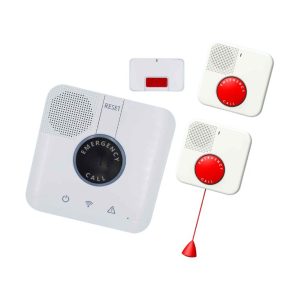

Key product features
What you should know
GetSafe Starter fits small condos, apartments, and one-bedroom homes. The package includes a base unit, one voice-activated wall button with a two-way speaker, and a wearable help button.
- The Starter’s monthly monitoring fee is $29.95 plus a $79 one-time equipment fee.
- A fall detection necklace is available for $10 per month.
- You can add extra wall buttons to customize your package.
GetSafe Standard vs. Select
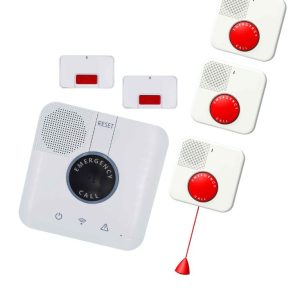

Key product features
What you should know
GetSafe recommends the Select package for four and five-bedroom homes. The package includes five wall buttons, but you can add extra buttons.
- The Select’s monthly monitoring fee is $29.95 plus a $307 one-time equipment fee.
- A fall detection necklace is available for $10 per month.
GetSafe vs. competitors

|
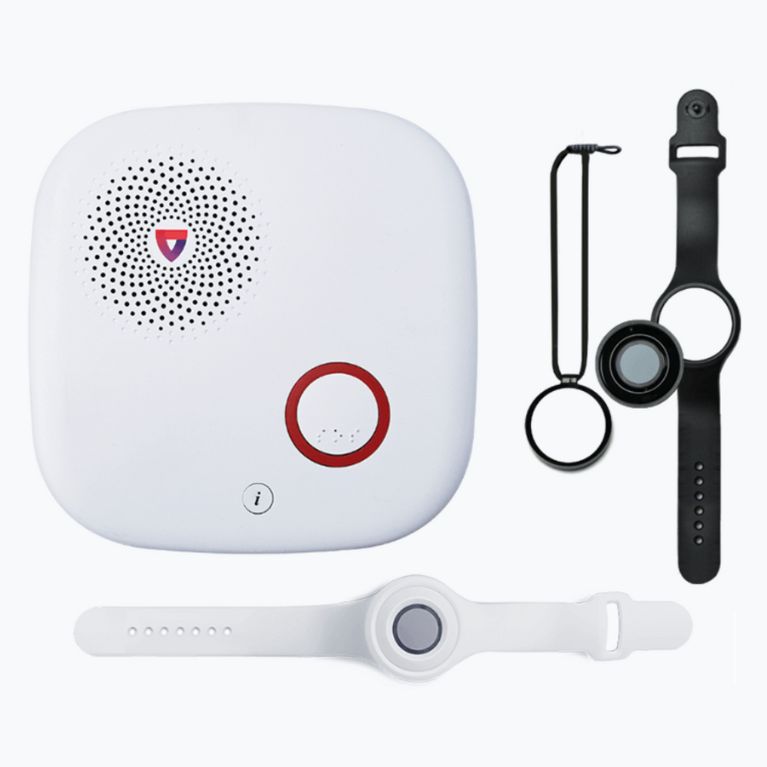
|
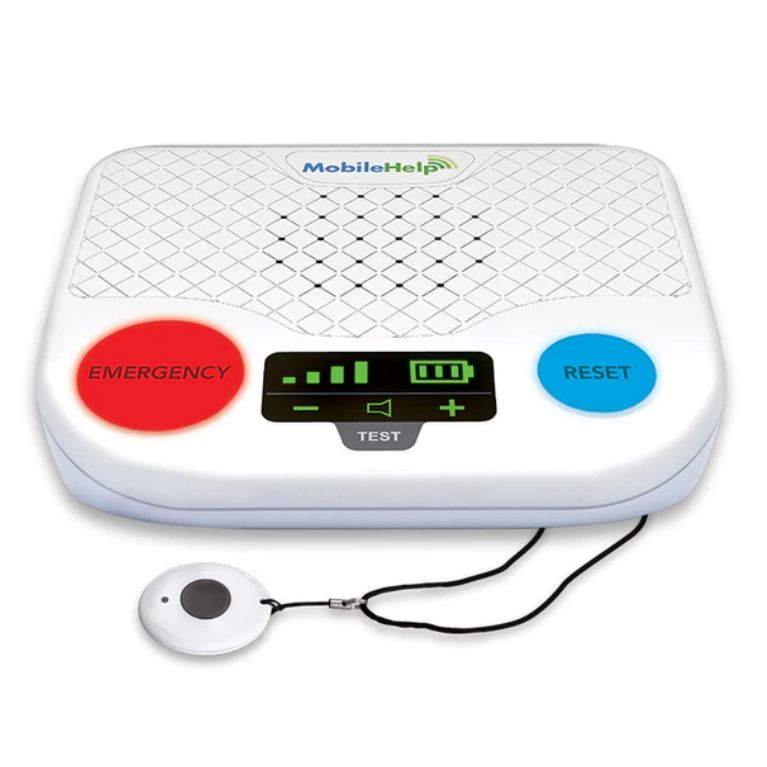
|
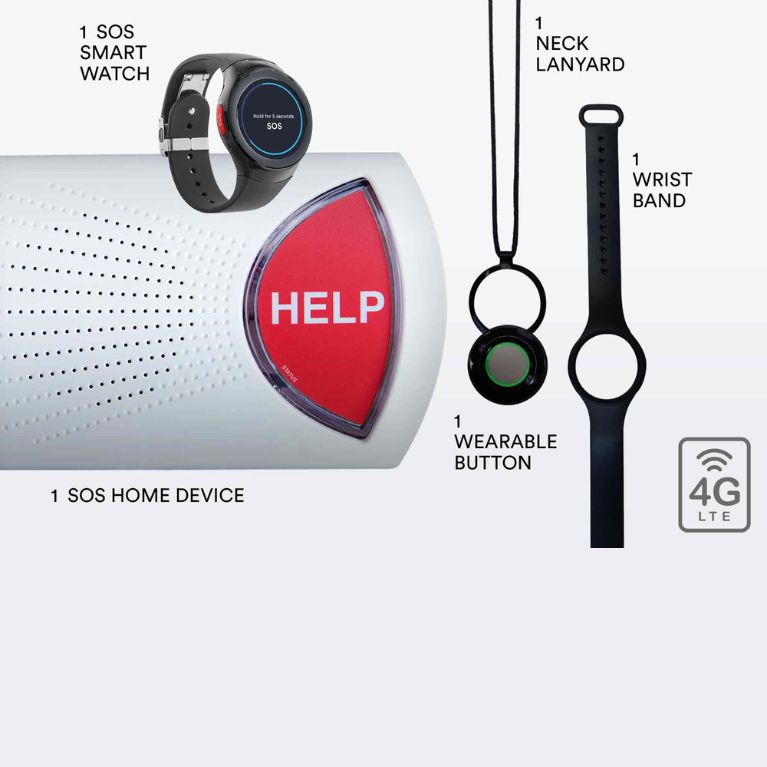
|
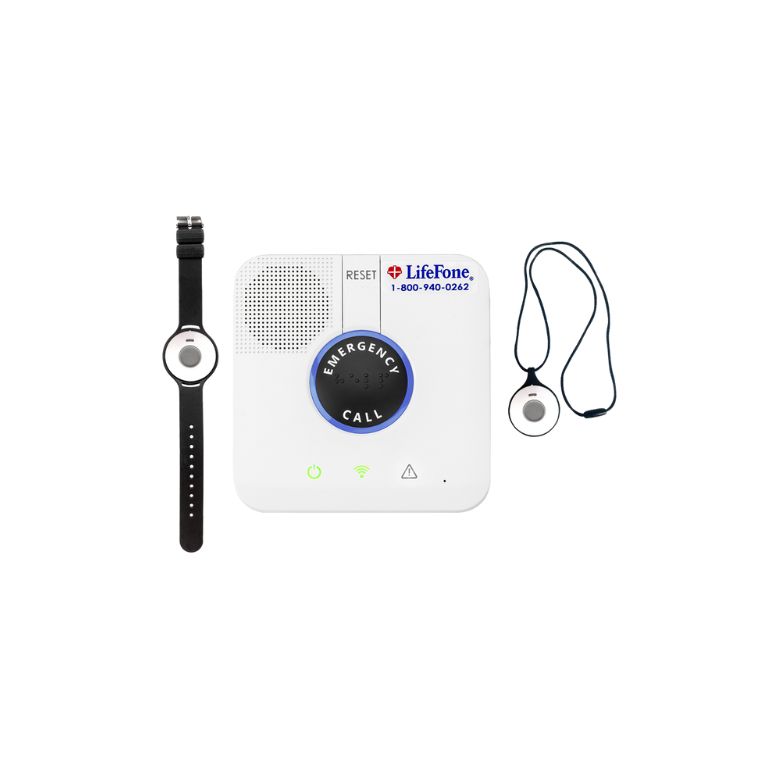
|
|
| GetSafe Standard | Medical Guardian MGHome Cellular | MobileHelp Classic | Bay Alarm Medical SOS Home | LifeFone At-Home Cellular | |
| Rating | |||||
| Monthly price | $29.95 | $37.95 | $24.95 | $29.95 | $34.95 |
| Equipment fee | $179 | $149.95 | $0 | $0 | $0 |
| Fall detection | Yes, $10/month | Yes, $10/month | Yes, $11/month | Yes, $10/month | Yes, $5/month |
| Battery life | 32 hours (base unit) | 32 hours (base unit) | 30 hours | 32 hours | 32 hours |
| In-home range | 800 feet | 1,400 feet | 1,400 feet | 1,000 feet | 1,300 feet |
Medical Guardian MGHome Cellular offers nearly double the at-home range of GetSafe between the wearable help button and base unit (1,400 feet vs. 800 feet). It’s also compatible with voice-activated and standard push-wall buttons within 500 feet of the base unit. Unlike GetSafe, you can’t communicate with the monitoring center via Medical Guardian’s voice-activated wall buttons.
MobileHelp Classic also offers a more extensive at-home range (1,400 feet). Push wall buttons are available but don’t have a two-way speaker or voice activation. Bay Alarm Medical SOS Home has a 1,000-foot range, and you can choose AT&T or Verizon cellular coverage. Push buttons are available to add to your at-home system.
LifeFone At-Home Cellular has a 1,300-foot range between the base unit and the wearable help button. Push buttons are also available, and fall detection is $5 per month—half the industry average.
FAQs
How does Getsafe work?
GetSafe is a medical alert system designed to work throughout your home. The base unit and wall buttons use AT&T cell service to connect to a 24/7 monitoring center. You can call the monitoring center using the base unit, a voice-activated button, a push button, a wearable help button, or a fall detection necklace. Depending on the situation, the agent dispatches emergency responders, contacts loved ones, or both.
How much do GetSafe medical alert systems cost?
GetSafe medical alert systems cost $29.95 per month, with a $79–$307 one-time equipment fee depending on the package you chose. Fall detection is available for an extra $10 per month.
Does GetSafe have fall detection?
Yes, you can add a fall detection necklace to any GetSafe package for $10 per month.
Our experts
Amanda Marten, MSN, FNP-C
Amanda Marten is a Family Nurse Practitioner and freelance writer. She currently works as a Nurse Practitioner in urgent care. She enjoys developing relationships with her patients and educating them about their health while promoting evidence-based research.
Krista Manning
Krista Manning is an accomplished medical copy editor and fact-checker who stands out in the pharmaceutical, health, and wellness domains. With a meticulous eye for detail and a command of medical language, Krista ensures the accuracy and clarity of content. Beyond her professional expertise, Krista is an advocate for mental health awareness. Recognizing the crucial intersection of psychological and physical well-being, she actively contributes to projects that promote mental health awareness within the healthcare narrative. Krista’s commitment extends beyond the pages she edits, emphasizing the holistic nature of health communication.

Emily Breaux
Emily Breaux
About Author
Emily is a health and wellness writer with a background in marketing and secondary education. She enjoys covering wellness topics that help readers navigate aging, caregiving, sleep, and nutritional health. Emily specializes in medical alert systems and has hand-tested more than 20 devices. Her work has been featured in National Council on Aging, HelpGuide, AgingInPlace.org, and MarketWatch.
Emily is based in New Orleans and enjoys neighborhood walks, practicing yoga, performing in local theatre productions, and finding her next read at the library.
References
- National Institute on Aging. Aging in Place: Growing Older at Home. Accessed October 1, 2024.
- Moreland, B. L., Kakara, R., Haddad, Y. K., Shakya, I., Bergen, G. A Descriptive Analysis of Location of Older Adult Falls That Resulted in Emergency Department Visits in the United States, 2015. American Journal of Lifestyle Medicine. 2021; 15(6): 590–597. doi: 10.1177/1559827620942187
- YouTube. How to Replace the Battery in the GetSafe Medical Alert Accessories. Accessed September 27, 2024.
- Moreland, B. L., Kakara, R., Haddad, Y. K., Shakya, I., & Bergen, G. (2020, August 7). A descriptive analysis of location of older adult falls that resulted in emergency department visits in the United States, 2015. American journal of lifestyle medicine. https://www.ncbi.nlm.nih.gov/pmc/articles/PMC8669898/
- Appeadu, M. K., Bordoni, B. Falls and Fall Prevention in Older Adults. StatPearls—NCBI Bookshelf. https://www.ncbi.nlm.nih.gov/books/NBK560761/
- MeetCaregivers. Understanding the Different Types of Caregivers Accessed October 1, 2024.
- WebMD. What Are Activities of Daily Living (ADLs)? Accessed October 1, 2024.
- Medicare.gov. Parts of Medicare. Accessed September 27, 2024.
- Medicare.gov. Your health plan options. Accessed September 27, 2024.
